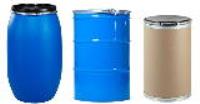 Add My Company
Add My Company
Sign In

Drums are a fantastic way of storing and transporting several different types of materials and resources.
They are used widely across industries including waste management, healthcare and food services.
However, their function in such a broad range of sectors means there isn’t a ‘one size fits all’ solution.
Instead there are several types, each made from a different material and designed to serve a different purpose.
That can make finding the most appropriate one for your needs a challenge, which is where we come in.
PLASTIC DRUMS
The most commonly used are plastic drums because they can be used for a wide variety of materials.
Usually made of HDPE (high-density polyethylene), which is resistant to both high and low pH contents, they are ideal for storing and transporting hazardous and non-hazardous liquid materials.
The thick walls of a plastic drum mean they are usually leak-proof.
Their construction also makes them UV-resistant, so there is a reduced chance of any heat or light damage to the contents inside.
Although not the most environment-friendly option, they are durable, which means they can be reused time and again if properly cleaned out and maintained.
That represents real value for money.
Plastic drums also come in two different designs; open-top and tight-headed.
Open-top drums are designed to allow you easy access to the contents, so are ideal for storing liquids you need to dip into simply by removing the lid.
However, they are better suited for storing dry materials.
Tight-headed drums are perfect for storing and transporting liquid materials because the lid is more securely fastened to the top.
For that reason, there is a reduced chance of spillage or accidental opening.
STEEL DRUMS
As the name suggests, these are constructed from steel which makes them highly durable and pretty much leak-proof.
They are ideal for storing, transporting and containing toxic and hazardous materials.
Their robustness ensures maximum protection because they won’t easily bend, crack or tear in transit.
Not only are they unlikely to tear or leak, but they also provide protection against fire damage.
Should a fire break start in your storage facility, the internal contents will be well-insulated.
Steel drums are also easy to stack on top of each other, which makes them a sound option if you’ve got a smaller storage area and need to optimise the space available.
Another benefit of steel drums is that, once they reach the end of a lifespan, they can be recycled without complications.
Therefore they are a sensible choice for anybody that wants a storage drum that lasts a long time but also won’t negatively impact the environment.
FIBRE DRUMS
This type of drum is a good all-rounder for packaging, but it is unsuitable for storing or transporting toxic or hazardous substances.
They shouldn't be chosen for liquids either unless they are lined beforehand with an appropriate material such as a formed drum liner.
They are, however, hard-wearing and an eco-friendly option because they will degrade naturally over time.
Once they do, they and can easily be recycled at the end of a lifespan.
This also makes them a attractive option for those businesses looking to introduce more sustainability into their working processes.
Fibre drums are also lightweight, which makes them easier to move around as required.
However, don’t let that fool you; they are renowned for being incredibly sturdy and will easily store materials without a risk of tearing, breaking or leaking.
Their fibreboard construction also makes them a more affordable way to ship materials - compared to plastic or steel alternatives - because they are lightweight.
They are also available to buy cheaply, and in a range of sizes to suit specific needs.
WHICH DRUM IS RIGHT FOR YOU?
As you can see, each of these drums comes with its own benefits and features.
When you’re looking for a storage solution, you need to determine the intended use.
If you’re going to be using a drum for any type of liquid or hazardous material, it would be best to stick with a plastic or steel option.
You can use a fibre drum if you want, but you must make sure it’s lined appropriately.
If you are looking to store food produce, then a plastic drum would be the best option due to its UV resistance and thick, leak-proof walls.
They will keep contents safe, and will make sure the quality of the food remains intact.
Steel drums are the best choice if you’re looking for premium, top-of-the-line protection for your materials during storage and transportation.
They also make a great choice when you need to store a volume of material because you can easily and securely stack them.
The best drum for an environment-conscious person is a fibre one that degrades over time and can be easily recycled or repurposed at the end of its life.
Fibre drums are also the best option for smaller businesses, or for anybody on a budget, because they cost much less than plastic and steel drums to ship and transport due to their lightweight build.
For more information on The different types of drums and their benefits talk to ITP Packaging Ltd
Enquire Now
List your company on FindTheNeedle.

